when和while引导的时间状语从句与这一时态连用
- 格式:doc
- 大小:23.00 KB
- 文档页数:8
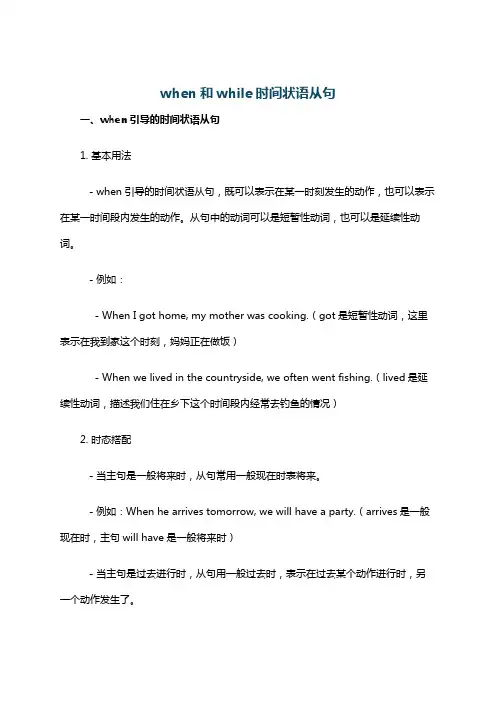
when和while时间状语从句一、when引导的时间状语从句1. 基本用法- when引导的时间状语从句,既可以表示在某一时刻发生的动作,也可以表示在某一时间段内发生的动作。
从句中的动词可以是短暂性动词,也可以是延续性动词。
- 例如:- When I got home, my mother was cooking.(got是短暂性动词,这里表示在我到家这个时刻,妈妈正在做饭)- When we lived in the countryside, we often went fishing.(lived是延续性动词,描述我们住在乡下这个时间段内经常去钓鱼的情况)2. 时态搭配- 当主句是一般将来时,从句常用一般现在时表将来。
- 例如:When he arrives tomorrow, we will have a party.(arrives是一般现在时,主句will have是一般将来时)- 当主句是过去进行时,从句用一般过去时,表示在过去某个动作进行时,另一个动作发生了。
- 例如:I was reading a book when he came in.(was reading是过去进行时,came是一般过去时)3. 位置特点- when引导的时间状语从句可位于主句之前或之后。
当位于主句之前时,从句后常用逗号与主句隔开。
- 例如:When it rains, the ground gets wet.(从句在前)- The birds fly south when winter comes.(从句在后)二、while引导的时间状语从句1. 基本用法- while引导的时间状语从句,从句中的动词必须是延续性动词,表示在某一时间段内,主句和从句的动作同时发生。
- 例如:While I was reading, my sister was watching TV.(reading和watching都是延续性动词,说明我读书和妹妹看电视这两个动作同时进行)2. 时态搭配- 当主句和从句都是过去进行时,表示两个动作在过去某一时间段内同时进行。
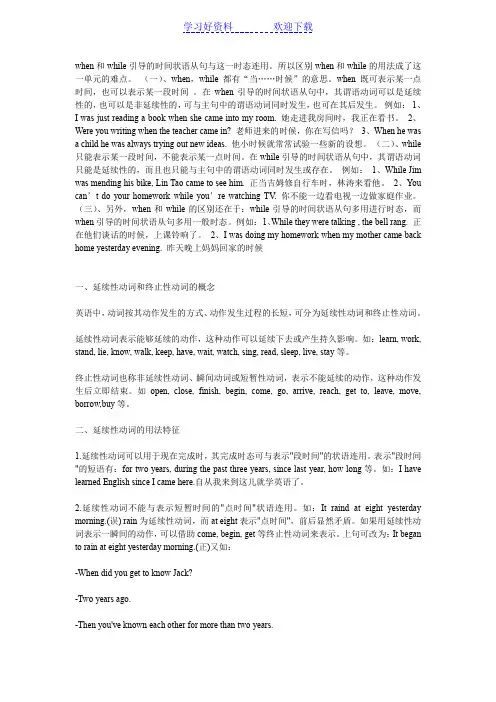
when和while引导的时间状语从句与这一时态连用。
所以区别when和while的用法成了这一单元的难点。
(一)、when,while都有“当……时候”的意思。
when既可表示某一点时间,也可以表示某一段时间。
在when引导的时间状语从句中,其谓语动词可以是延续性的,也可以是非延续性的,可与主句中的谓语动词同时发生,也可在其后发生。
例如:1、I was just reading a book when she came into my room. 她走进我房间时,我正在看书。
2、Were you writing when the teacher came in? 老师进来的时候,你在写信吗?3、When he was a child he was always trying out new ideas. 他小时候就常常试验一些新的设想。
(二)、while 只能表示某一段时间,不能表示某一点时间。
在while引导的时间状语从句中,其谓语动词只能是延续性的,而且也只能与主句中的谓语动词同时发生或存在。
例如:1、While Jim was mending his bike, Lin Tao came to see him. 正当吉姆修自行车时,林涛来看他。
2、You can’t do your homework while you’re watching TV. 你不能一边看电视一边做家庭作业。
(三)、另外,when和while的区别还在于:while引导的时间状语从句多用进行时态,而when引导的时间状语从句多用一般时态。
例如:1、While they were talking , the bell rang. 正在他们谈话的时候,上课铃响了。
2、I was doing my homework when my mother came back home yesterday evening. 昨天晚上妈妈回家的时候一、延续性动词和终止性动词的概念英语中,动词按其动作发生的方式、动作发生过程的长短,可分为延续性动词和终止性动词。
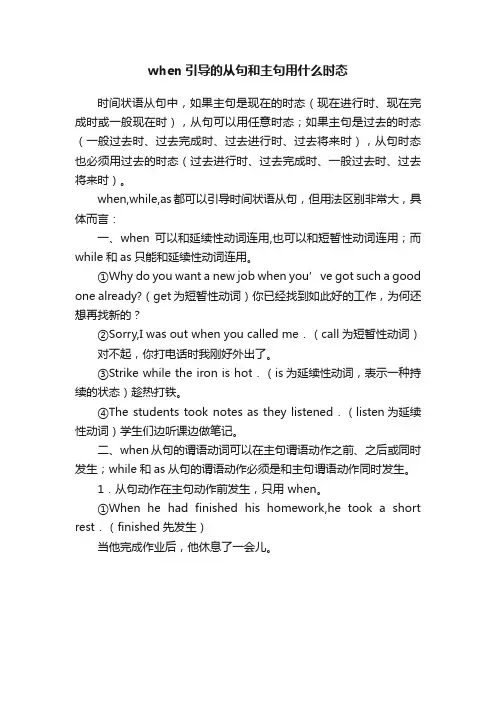
when引导的从句和主句用什么时态
时间状语从句中,如果主句是现在的时态(现在进行时、现在完成时或一般现在时),从句可以用任意时态;如果主句是过去的时态(一般过去时、过去完成时、过去进行时、过去将来时),从句时态也必须用过去的时态(过去进行时、过去完成时、一般过去时、过去将来时)。
when,while,as都可以引导时间状语从句,但用法区别非常大,具体而言:
一、when可以和延续性动词连用,也可以和短暂性动词连用;而while和as只能和延续性动词连用。
①Why do you want a new job when you’ve got such a good one already?(get为短暂性动词)你已经找到如此好的工作,为何还想再找新的?
②Sorry,I was out when you called me.(call为短暂性动词)
对不起,你打电话时我刚好外出了。
③Strike while the iron is hot.(is为延续性动词,表示一种持续的状态)趁热打铁。
④The students took notes as they listened.(listen为延续性动词)学生们边听课边做笔记。
二、when从句的谓语动词可以在主句谓语动作之前、之后或同时发生;while和as从句的谓语动作必须是和主句谓语动作同时发生。
1.从句动作在主句动作前发生,只用 when。
①When he had finished his homework,he took a short rest.(finished先发生)
当他完成作业后,他休息了一会儿。
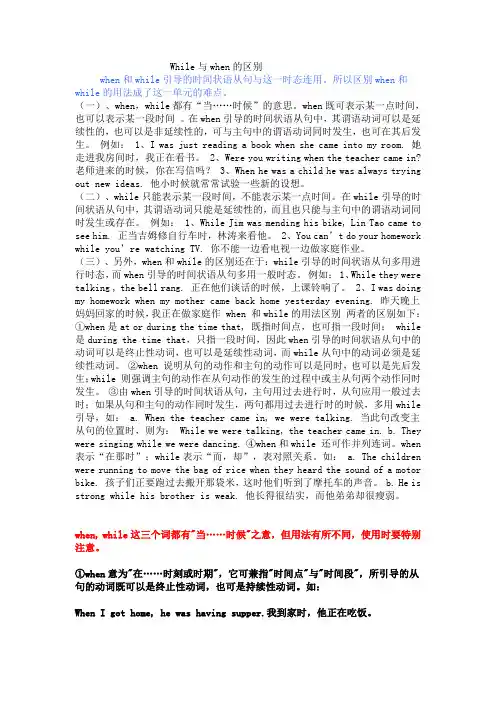
While与when的区别when和while引导的时间状语从句与这一时态连用。
所以区别when和while的用法成了这一单元的难点。
(一)、when,while都有“当……时候”的意思。
when既可表示某一点时间,也可以表示某一段时间。
在when引导的时间状语从句中,其谓语动词可以是延续性的,也可以是非延续性的,可与主句中的谓语动词同时发生,也可在其后发生。
例如: 1、I was just reading a book when she came into my room. 她走进我房间时,我正在看书。
2、Were you writing when the teacher came in? 老师进来的时候,你在写信吗? 3、When he was a child he was always trying out new ideas. 他小时候就常常试验一些新的设想。
(二)、while只能表示某一段时间,不能表示某一点时间。
在while引导的时间状语从句中,其谓语动词只能是延续性的,而且也只能与主句中的谓语动词同时发生或存在。
例如: 1、While Jim was mending his bike, Lin Tao came to see him. 正当吉姆修自行车时,林涛来看他。
2、You can’t do your homework while you’re watching TV. 你不能一边看电视一边做家庭作业。
(三)、另外,when和while的区别还在于:while引导的时间状语从句多用进行时态,而when引导的时间状语从句多用一般时态。
例如: 1、While they were talking , the bell rang. 正在他们谈话的时候,上课铃响了。
2、I was doing my homework when my mother came back home yesterday evening. 昨天晚上妈妈回家的时候,我正在做家庭作 when 和while的用法区别两者的区别如下:①when是at or during the time that, 既指时间点,也可指一段时间; while 是during the time that,只指一段时间,因此when引导的时间状语从句中的动词可以是终止性动词,也可以是延续性动词,而while从句中的动词必须是延续性动词。
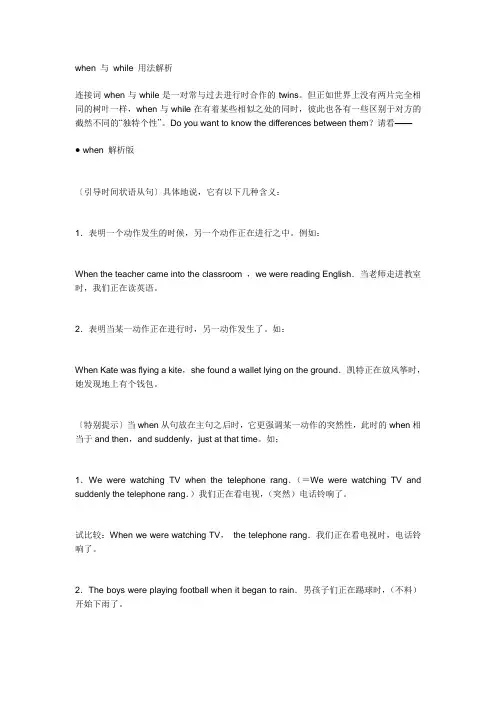
when 与while 用法解析连接词when与while是一对常与过去进行时合作的twins。
但正如世界上没有两片完全相同的树叶一样,when与while在有着某些相似之处的同时,彼此也各有一些区别于对方的截然不同的“独特个性”。
Do you want to know the differences between them?请看——● when 解析版〔引导时间状语从句〕具体地说,它有以下几种含义:1.表明一个动作发生的时候,另一个动作正在进行之中。
例如:When the teacher came into the classroom ,we were reading English.当老师走进教室时,我们正在读英语。
2.表明当某一动作正在进行时,另一动作发生了。
如:When Kate was flying a kite,she found a wallet lying on the ground.凯特正在放风筝时,她发现地上有个钱包。
〔特别提示〕当when从句放在主句之后时,它更强调某一动作的突然性,此时的when相当于and then,and suddenly,just at that time。
如;1.We were watching TV when the telephone rang.(=We were watching TV and suddenly the telephone rang.)我们正在看电视,(突然)电话铃响了。
试比较:When we were watching TV,the telephone rang.我们正在看电视时,电话铃响了。
2.The boys were playing football when it began to rain.男孩子们正在踢球时,(不料)开始下雨了。
3.I was taking a walk when I came across Lily.我正在散步时,(没想到)遇见了莉莉。
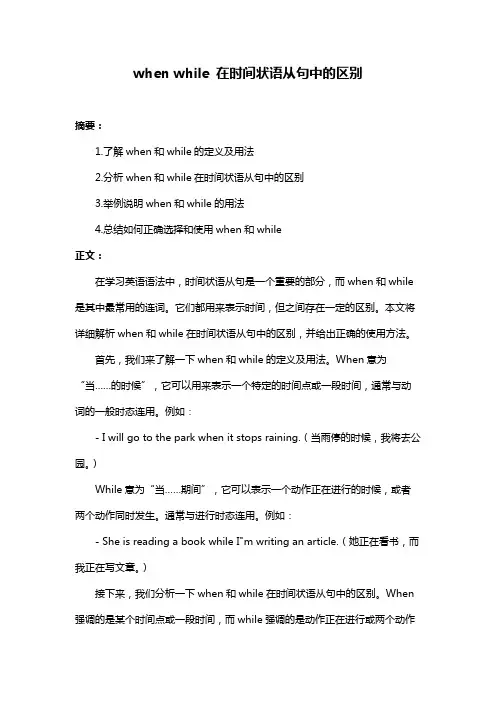
when while 在时间状语从句中的区别摘要:1.了解when和while的定义及用法2.分析when和while在时间状语从句中的区别3.举例说明when和while的用法4.总结如何正确选择和使用when和while正文:在学习英语语法中,时间状语从句是一个重要的部分,而when和while 是其中最常用的连词。
它们都用来表示时间,但之间存在一定的区别。
本文将详细解析when和while在时间状语从句中的区别,并给出正确的使用方法。
首先,我们来了解一下when和while的定义及用法。
When意为“当……的时候”,它可以用来表示一个特定的时间点或一段时间,通常与动词的一般时态连用。
例如:- I will go to the park when it stops raining.(当雨停的时候,我将去公园。
)While意为“当……期间”,它可以表示一个动作正在进行的时候,或者两个动作同时发生。
通常与进行时态连用。
例如:- She is reading a book while I"m writing an article.(她正在看书,而我正在写文章。
)接下来,我们分析一下when和while在时间状语从句中的区别。
When 强调的是某个时间点或一段时间,而while强调的是动作正在进行或两个动作同时发生。
这就需要我们在选择连词时,根据句子的实际意义来判断使用哪个连词。
例如:- I will call you when I arrive at the station.(我到达车站时给你打电话。
)- She dances while the music plays.(音乐播放时,她跳舞。
)通过以上例子,我们可以看出,when和while在时间状语从句中的区别主要在于强调的重点不同。
当我们需要表示某个时间点或一段时间时,选用when;当我们需要表示动作正在进行或两个动作同时发生时,选用while。
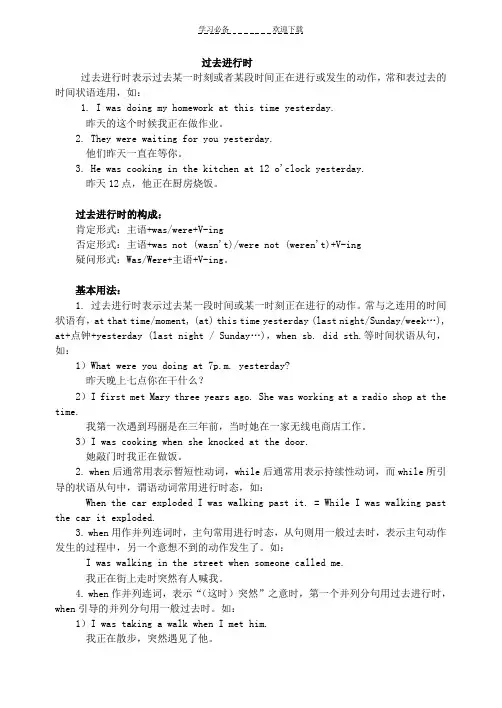
过去进行时过去进行时表示过去某一时刻或者某段时间正在进行或发生的动作,常和表过去的时间状语连用,如:1. I was doing my homework at this time yesterday.昨天的这个时候我正在做作业。
2. They were waiting for you yesterday.他们昨天一直在等你。
3. He was cooking in the kitchen at 12 o'clock yesterday.昨天12点,他正在厨房烧饭。
过去进行时的构成:肯定形式:主语+was/were+V-ing否定形式:主语+was not (wasn't)/were not (weren't)+V-ing疑问形式:Was/Were+主语+V-ing。
基本用法:1. 过去进行时表示过去某一段时间或某一时刻正在进行的动作。
常与之连用的时间状语有,at that time/moment, (at) this time yesterday (last night/Sunday/week…), at+点钟+yesterday (last night / Sunday…),when sb. did sth.等时间状语从句,如:1)What were you doing at 7p.m. yesterday?昨天晚上七点你在干什么?2)I first met Mary three years ago. She was working at a radio shop at the time.我第一次遇到玛丽是在三年前,当时她在一家无线电商店工作。
3)I was cooking when she knocked at the door.她敲门时我正在做饭。
2. when后通常用表示暂短性动词,while后通常用表示持续性动词,而while所引导的状语从句中,谓语动词常用进行时态,如:When the car exploded I was walking past it. = While I was walking past the car it exploded.3. when用作并列连词时,主句常用进行时态,从句则用一般过去时,表示主句动作发生的过程中,另一个意想不到的动作发生了。
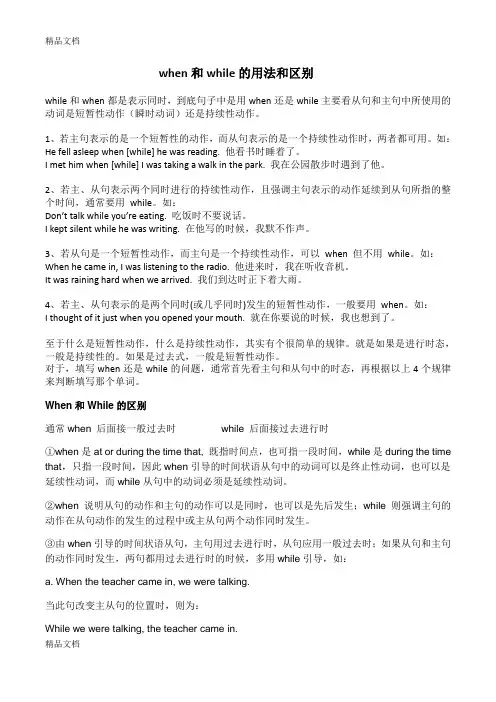
when和while的用法和区别while和when都是表示同时,到底句子中是用when还是while主要看从句和主句中所使用的动词是短暂性动作(瞬时动词)还是持续性动作。
1、若主句表示的是一个短暂性的动作,而从句表示的是一个持续性动作时,两者都可用。
如:He fell asleep when [while] he was reading. 他看书时睡着了。
I met him when [while] I was taking a walk in the park. 我在公园散步时遇到了他。
2、若主、从句表示两个同时进行的持续性动作,且强调主句表示的动作延续到从句所指的整个时间,通常要用while。
如:Don’t talk while you’re eating. 吃饭时不要说话。
I kept silent while he was writing. 在他写的时候,我默不作声。
3、若从句是一个短暂性动作,而主句是一个持续性动作,可以when 但不用while。
如:When he came in, I was listening to the radio. 他进来时,我在听收音机。
It was raining hard when we arrived. 我们到达时正下着大雨。
4、若主、从句表示的是两个同时(或几乎同时)发生的短暂性动作,一般要用when。
如:I thought of it just when you opened your mouth. 就在你要说的时候,我也想到了。
至于什么是短暂性动作,什么是持续性动作,其实有个很简单的规律。
就是如果是进行时态,一般是持续性的。
如果是过去式,一般是短暂性动作。
对于,填写when还是while的问题,通常首先看主句和从句中的时态,再根据以上4个规律来判断填写那个单词。
When和While的区别通常when 后面接一般过去时while 后面接过去进行时①when是at or during the time that, 既指时间点,也可指一段时间,while是during the time that,只指一段时间,因此when引导的时间状语从句中的动词可以是终止性动词,也可以是延续性动词,而while从句中的动词必须是延续性动词。
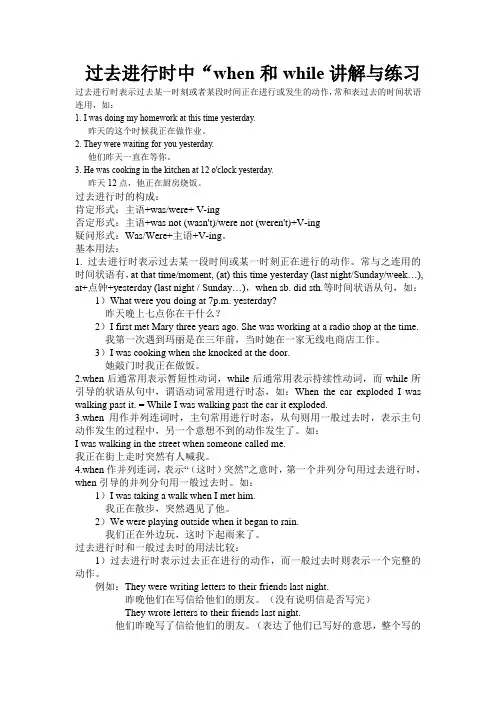
过去进行时中“when和while讲解与练习过去进行时表示过去某一时刻或者某段时间正在进行或发生的动作,常和表过去的时间状语连用,如:1. I was doing my homework at this time yesterday.昨天的这个时候我正在做作业。
2. They were waiting for you yesterday.他们昨天一直在等你。
3. He was cooking in the kitchen at 12 o'clock yesterday.昨天12点,他正在厨房烧饭。
过去进行时的构成:肯定形式:主语+was/were+ V-ing否定形式:主语+was not (wasn't)/were not (weren't)+V-ing疑问形式:Was/Were+主语+V-ing。
基本用法:1. 过去进行时表示过去某一段时间或某一时刻正在进行的动作。
常与之连用的时间状语有,at that time/moment, (at) this time yesterday (last night/Sunday/week…), at+点钟+yesterda y (last night / Sunday…),when sb. did sth.等时间状语从句,如:1)What were you doing at 7p.m. yesterday?昨天晚上七点你在干什么?2)I first met Mary three years ago. She was working at a radio shop at the time.我第一次遇到玛丽是在三年前,当时她在一家无线电商店工作。
3)I was cooking when she knocked at the door.她敲门时我正在做饭。
2.when后通常用表示暂短性动词,while后通常用表示持续性动词,而while所引导的状语从句中,谓语动词常用进行时态,如:When the car exploded I was walking past it. = While I was walking past the car it exploded.3.when用作并列连词时,主句常用进行时态,从句则用一般过去时,表示主句动作发生的过程中,另一个意想不到的动作发生了。
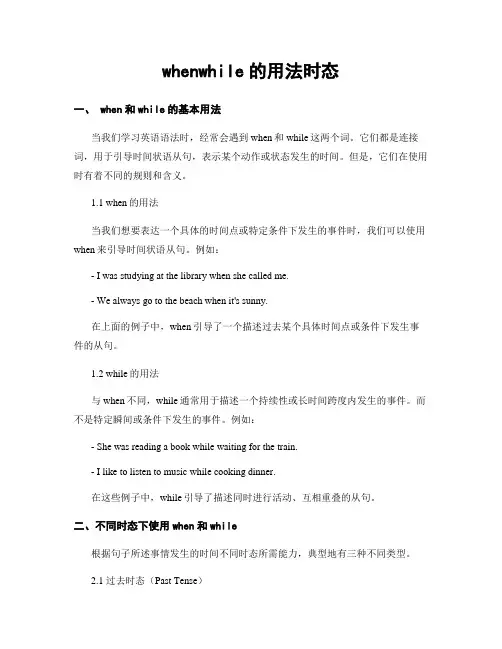
whenwhile的用法时态一、 when和while的基本用法当我们学习英语语法时,经常会遇到when和while这两个词。
它们都是连接词,用于引导时间状语从句,表示某个动作或状态发生的时间。
但是,它们在使用时有着不同的规则和含义。
1.1 when的用法当我们想要表达一个具体的时间点或特定条件下发生的事件时,我们可以使用when来引导时间状语从句。
例如:- I was studying at the library when she called me.- We always go to the beach when it's sunny.在上面的例子中,when引导了一个描述过去某个具体时间点或条件下发生事件的从句。
1.2 while的用法与when不同,while通常用于描述一个持续性或长时间跨度内发生的事件。
而不是特定瞬间或条件下发生的事件。
例如:- She was reading a book while waiting for the train.- I like to listen to music while cooking dinner.在这些例子中,while引导了描述同时进行活动、互相重叠的从句。
二、不同时态下使用when和while根据句子所述事情发生的时间不同时态所需能力,典型地有三种不同类型。
2.1 过去时态(Past Tense)当我们想要描述过去某个特定时刻或条件下发生的事件时,可以使用过去时态(Past Tense)结合when引导从句。
例如:- I was walking in the rain when I saw her.- They were having dinner when the phone rang.在这些例子中,主句和从句都采用了过去时态,从而表达出两个事件在过去某一时间点或条件下同时发生。
2.2 进行时态(Present Continuous)当我们想要描述现在或现阶段正在进行的活动时,可以使用进行时态(Present Continuous)结合while引导从句。
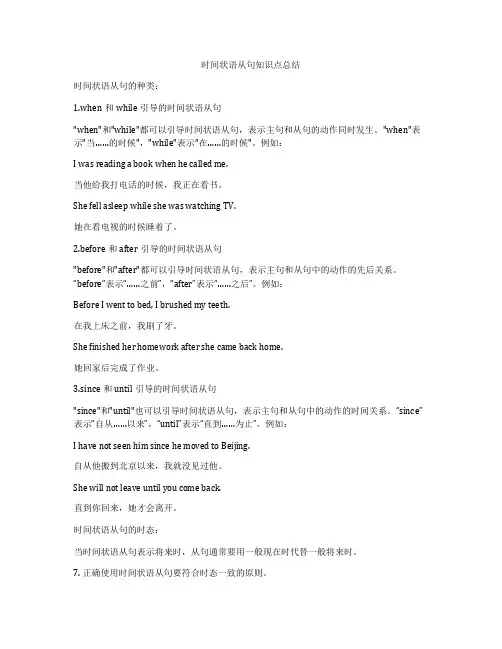
时间状语从句知识点总结时间状语从句的种类:1.when和while引导的时间状语从句"when"和"while"都可以引导时间状语从句,表示主句和从句的动作同时发生。
"when"表示"当……的时候","while"表示"在……的时候"。
例如:I was reading a book when he called me.当他给我打电话的时候,我正在看书。
She fell asleep while she was watching TV.她在看电视的时候睡着了。
2.before和after引导的时间状语从句"before"和"after"都可以引导时间状语从句,表示主句和从句中的动作的先后关系。
“before”表示“……之前”,“after”表示“……之后”。
例如:Before I went to bed, I brushed my teeth.在我上床之前,我刷了牙。
She finished her homework after she came back home.她回家后完成了作业。
3.since和until引导的时间状语从句"since"和"until"也可以引导时间状语从句,表示主句和从句中的动作的时间关系。
“since”表示“自从……以来”,“until”表示“直到……为止”。
例如:I have not seen him since he moved to Beijing.自从他搬到北京以来,我就没见过他。
She will not leave until you come back.直到你回来,她才会离开。
时间状语从句的时态:当时间状语从句表示将来时,从句通常要用一般现在时代替一般将来时。
7. 正确使用时间状语从句要符合时态一致的原则。
when和while引导时间状语从句的区别及用法when和while引导时间状语从句的基本区别:(一)、when,while都有“当时候”的意思。
when既可表示某一点时间,也可以表示某一段时间。
在when引导的时间状语从句中,其谓语动词可以是延续性的,也可以是非延续性的,可与主句中的谓语动词同时发生,也可在其后发生。
例如: 1、I was just reading a book when she came into my room.她走进我房间时,我正在看书。
2、Were you writing when the teacher came in?老师进来的时候,你在写信吗?3、When he was a child he was always trying out new ideas.他小时候就常常试验一些新的设想。
(二)、while只能表示某一段时间,不能表示某一点时间。
在while引导的时间状语从句中,其谓语动词只能是延续性的,而且也只能与主句中的谓语动词同时发生或存在。
例1、While Jim was mending his bike, Lin Tao came to see him.正当吉姆修自行车时,林涛来看他。
2、You can’t do your homework while you’re watching TV.你不能一边看电视一边做家庭作业。
(三)、另外,when和while的区别还在于:while引导的时间状语从句多用进行时态,而when引导的时间状语从句多用一般时态。
例如:1、While they were talking , the bell rang.正在他们谈话的时候,上课铃响了。
2、I was doing my homework when my mother came back home yesterday evening.昨天晚上妈妈回家的时候,我正在做家庭作通过观察,我们可以这样理解:when引导的从句里动作发生的时间相对主句动作发生的时间要短些;while引导的从句里的动作发生的时间相对主句而言更长些。
when和while引导的时间状语从句
时间状语从句用来表示一个动作或状态发生的时间。
当引导时间状语从句时,可使用"when"和"while"。
1. "When"引导的时间状语从句:
- We will go to the park when it stops raining.(当雨停下来时,我们会去公园。
)
- I always feel happy when I see her smile. (当我看到她微笑时,我总是感到快乐。
)
2. "While"引导的时间状语从句:
- While I was cooking, the phone rang.(当我正在做饭时,电话响了。
)
- I like to listen to music while I'm exercising.(当我在锻炼时,我喜欢听音乐。
)
"when"和"while"都可以引导时间状语从句,但它们有一些差异:
- "When"通常表示一个单一的时间点或一个特定的情况发生时;"while"则表示一个相对较长的时间段内的反复动作或重复状态。
- "When"从句和主句之间的动作可以同时发生,也可以是先后发生的;而"while"从句和主句之间的动作通常是同时进行的。
- "When"从句的谓语动词常用一般现在时;而"while"从句的谓语动词可以使用进行时态来表示重复动作或持续状态。
w h i l e和w h e n引导的时间状语从句主句用一般时Company Document number:WTUT-WT88Y-W8BBGB-BWYTT-19998while和when引导的时间状语从句,主句用(一般过去时)从句用(过去进行).while引导的从句要加延续性动词,而when 延续和短暂性动词都可以,。
6. 另外,when和while的区别还在于:while引导的时间状语从句多用过去进行时态,而when引导的时间状语从句多用一般过去时态。
While they were talking , the bell rang.正在他们谈话的时候,上课铃响了。
I was doing my homework when my mother came back home yesterday evening.昨天晚上妈妈回家的时候,我正在做家庭作业。
我在做饭的时候简正在练习。
当此句改变主从句的位置时,则用when引导。
1.While we____(wait)for the bus,a girl__________(run)up to us.2.(telephone)a friend when Bob__________(come)in.3. mother______(put)Cathy to bed,the door bell_______(ring).4. I________(walk)in the park,it__________(begin) to rain.5.(read)when they______(hear)a knock at the door.6.(have)my breakfast t at half past six yesterday morning.7.(do)at that time We_____(watch)TV.8.(have)a meeting at 4 yesterday afternoonNo,(clean)the classroom.9. the bell rang,jenny_____(wait )in her seat.10.(make)her dress the whole afternoon.1 .I ______ a meal when you _____ me.a. cooked, were ringingb. was cooking, rangc. was cooking, were ringingd. cooked, rangsaid he _____ to draw a plane on the blackboard at that time.a. triesb. triedc. was tryingd. will tryshe ______ TV, she ______ a sound outside the room.a. was watching, was hearingb. watched, was hearingc. watched, heardd. was watching, heard_____ a football game from 7 to 9 last night.a. were watchingb. watchc. watchedd. are watching____ his father on the farm the whole afternoon last Saturday.a. helpsb. would helpc. was helpingd. is helpingmother _______ some washing, I _____ a kite for Kate.a. did, madeb. was doing, madec. was doing, was makingd. did, was making____ some cooking at that time, so he _____ mea. did, heardb. did, didn't hearc. was doing, heardd. was doing, didn't heartime yesterday jack _____ his bike. He _____ TVa. repaired, didn't watchb. was repairing, watchedc. repaired, watchedd. was repairing, wasn't watching。
when和while引导的时间状语从句与这一时态连用。
所以区别when和while的用法成了这一单元的难点。
(一)、when,while都有“当……时候”的意思。
when既可表示某一点时间,也可以表示某一段时间。
在when引导的时间状语从句中,其谓语动词可以是延续性的,也可以是非延续性的,可与主句中的谓语动词同时发生,也可在其后发生。
例如:1、I was just reading a book when she came into my room.她走进我房间时,我正在看书。
2、Were you writing when the teacher came in?老师进来的时候,你在写信吗?3、When he was a child he was always trying out new ideas.他小时候就常常试验一些新的设想。
(二)、while只能表示某一段时间,不能表示某一点时间。
在while引导的时间状语从句中,其谓语动词只能是延续性的,而且也只能与主句中的谓语动词同时发生或存在。
例如:1、While Jim was mending his bike, Lin Tao came to see him.正当吉姆修自行车时,林涛来看他。
2、You can’t do your homework while you’re watching TV.你不能一边看电视一边做家庭作业。
(三)、另外,when和while的区别还在于:while引导的时间状语从句多用进行时态,而when引导的时间状语从句多用一般时态。
例如:1、While they were talking , the bell rang.正在他们谈话的时候,上课铃响了。
2、I was doing my homework when my mother came back home yesterday evening.昨天晚上妈妈回家的时候,我正在做家庭作1. ----------she comes , I shall tell her to wait for you.A. WhenB. AsC. WhileD. What2. ----------she got older, she got wiser.A. WhenB. AsC. WhileD. That3.----------Peter was reading , his wife was cooking.A. WhenB. AsC. WhileD. Thatwhen as while① when 表示较短的时间,有的时候也可以指一段时间。
在 while和 when的后面常跟 v-ing形式,相当于进行时态。
例如:①When(he was) crossing the street, he was hit by a car.过马路时,他被汽车撞了。
【注意】如果两句主语不一致,则he was不能省略。
例如:②When he was crossing the street, a car knocked him down.▲在其它一些连词的后面,也常见到v-ed形式,这时表示的是被动。
例如:①He won't give you a reply unless(he is) asked.如果你不问他,他不会回答的。
②He said he would come if(he was) invited.他说如果受到邀请,他会来的。
2.when/while引导的时间状语从句中的主语,如果与主句的主语(或逻辑主语)相同,常用when/while+-ing形式短语或过去分词短语、形容词、名词、介词短语等的结构来代替。
如:①You must be careful when you cross the street. (=You must be careful when crossing the street. )过街时要当心。
②When he turned on the light, he was surprised to see his son lying on the floor. (=When turning on the light, he was surprised to see his son lying on the floor. )他打开灯,惊讶地看见儿子躺在地上。
③Don't reach sideways while you are standing on a ladder. (=Don't reach sideways while standing on a ladder)站在梯子上时不要伸手去拿东西。